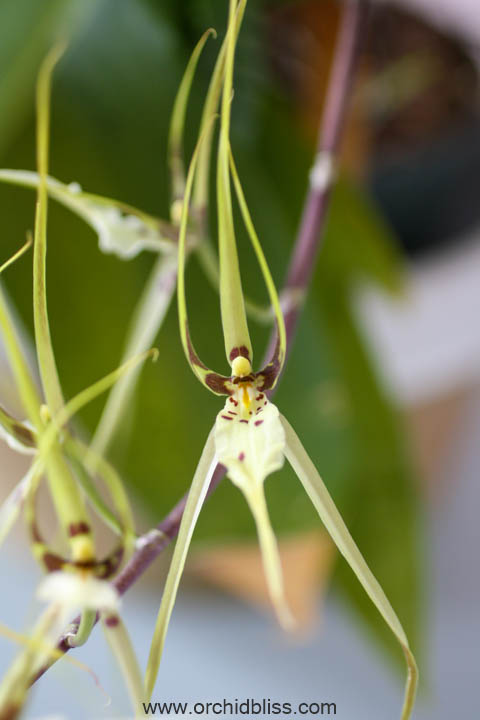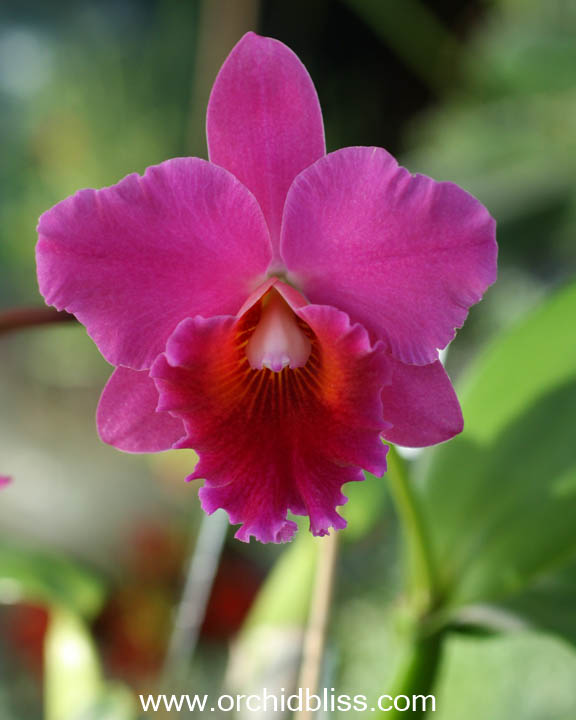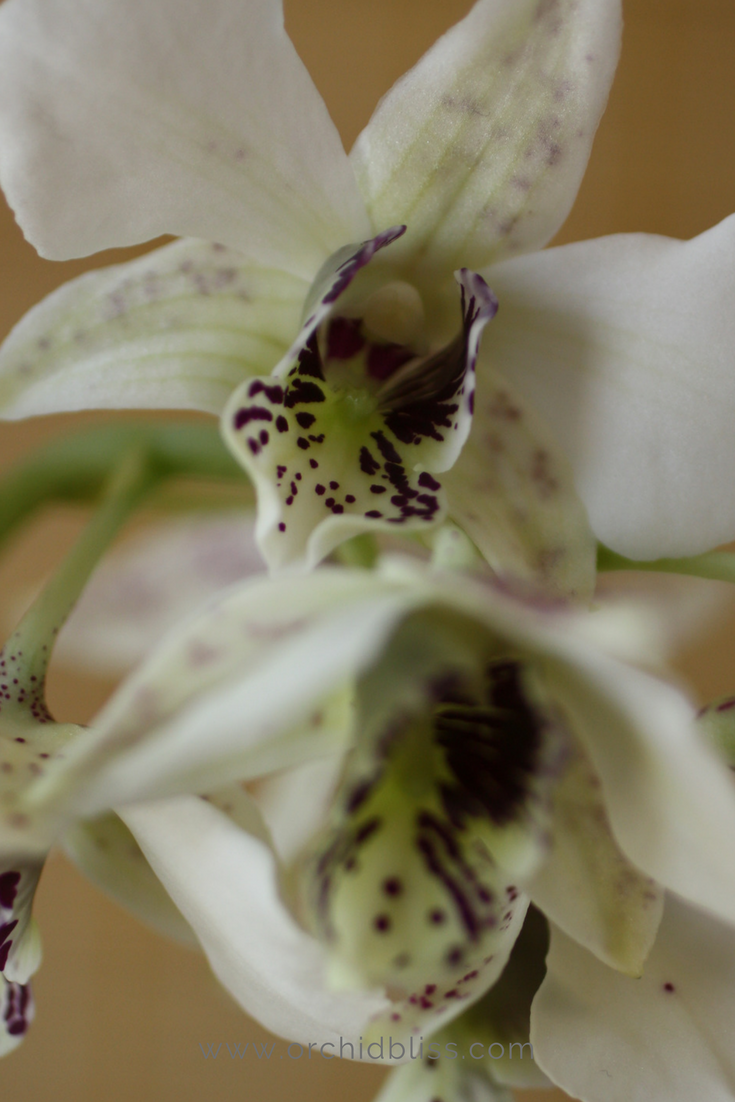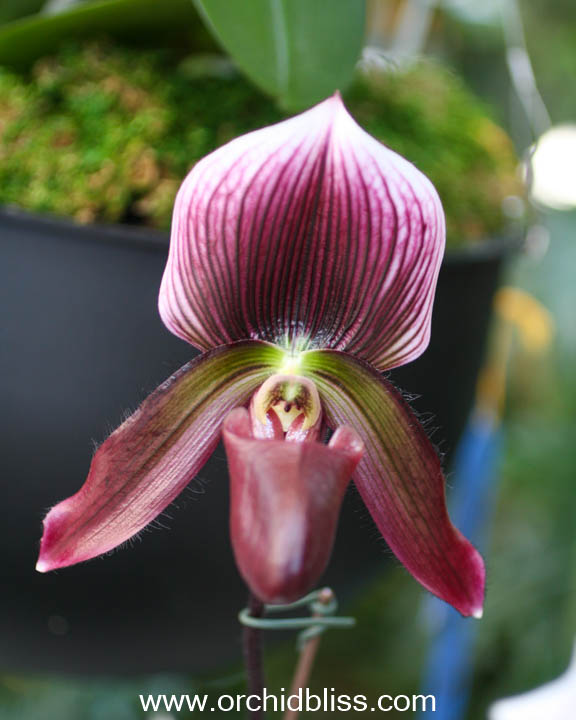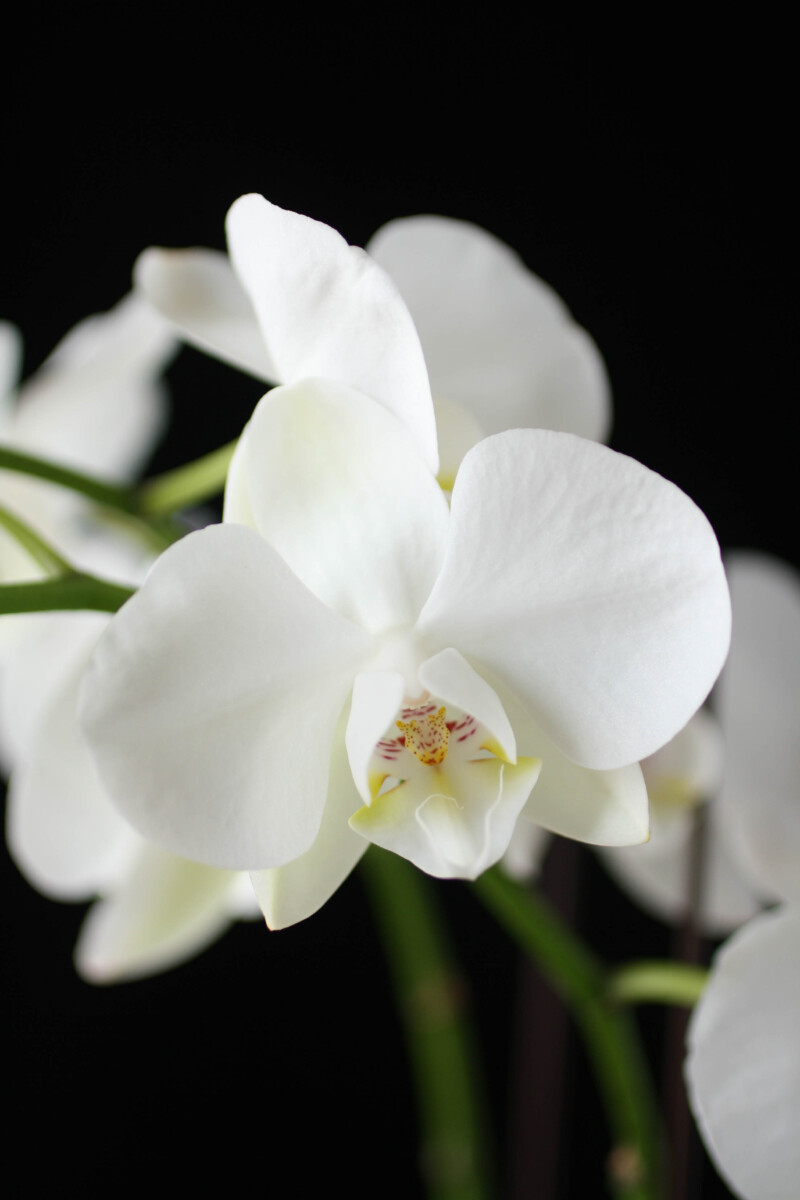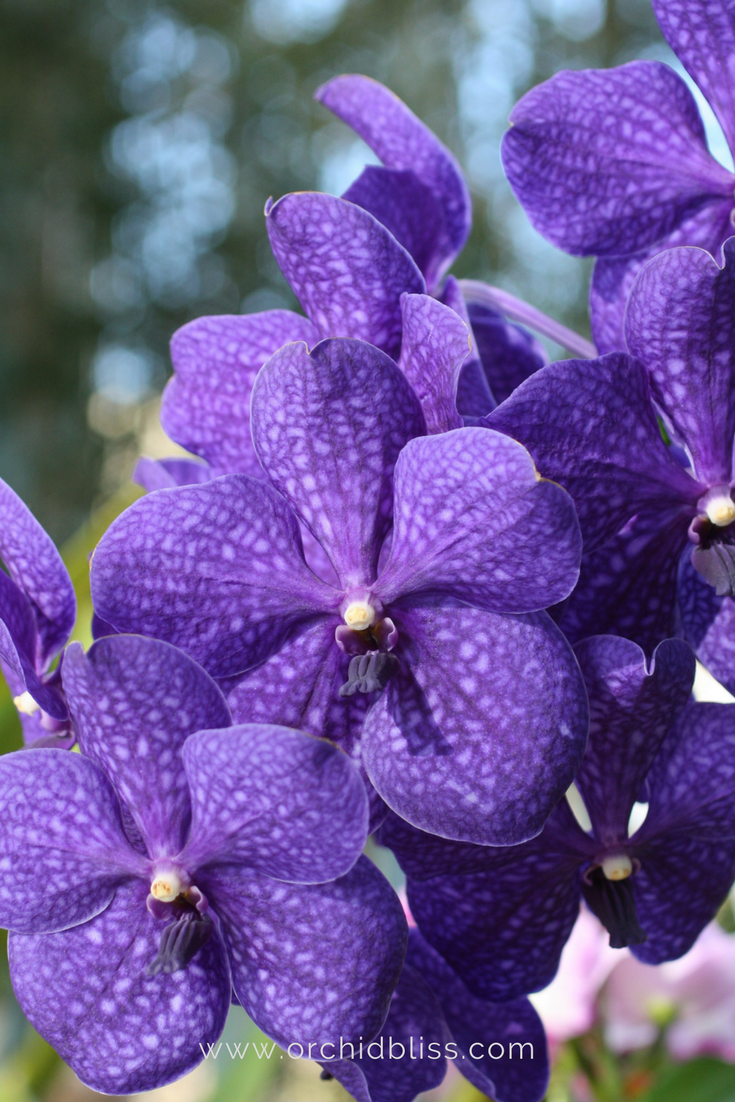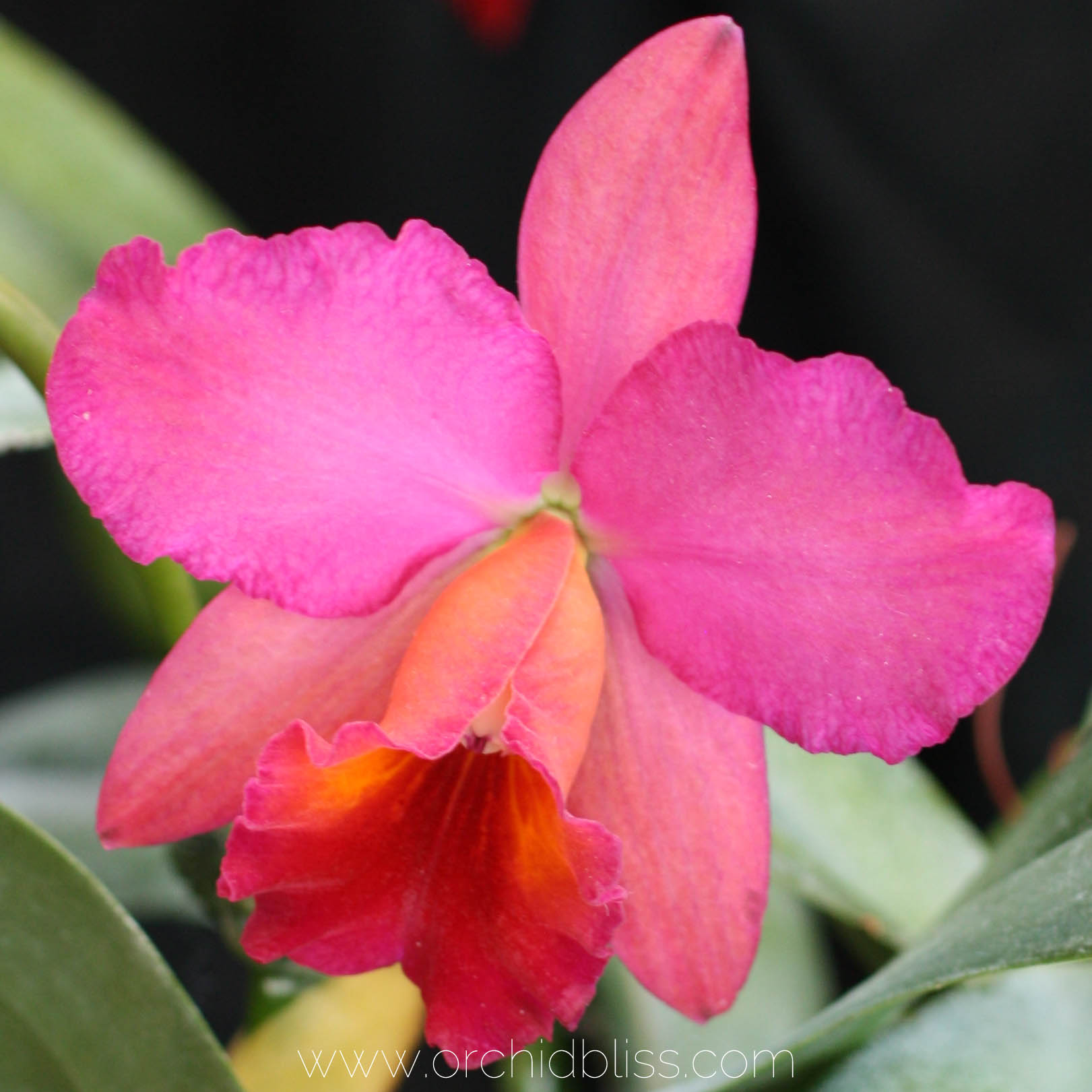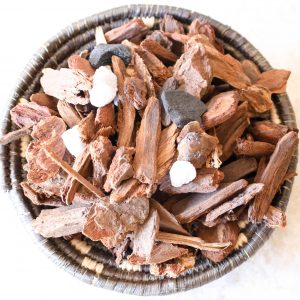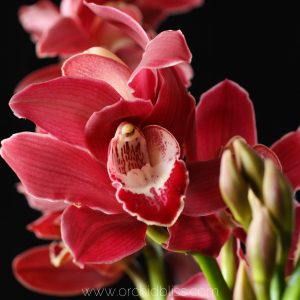
Over the past dozen years of growing – and blooming – orchids, I’ve learned a lot. In this post, I want to share with you 20 tips to help you rebloom orchids.
The key to rebloom orchids is to mimic their native climate. Specifically regarding temperature and light – but we will discuss other factors as well. By replicating your orchid’s natural growing conditions you’ll be able to rebloom a variety of orchids that fit within your growing environment.
If your orchid has lost its flowers and shows no signs of reblooming, you may be wondering: Do orchids bloom more than once? Happily, the answer is YES! Let’s learn how to rebloom your orchids.
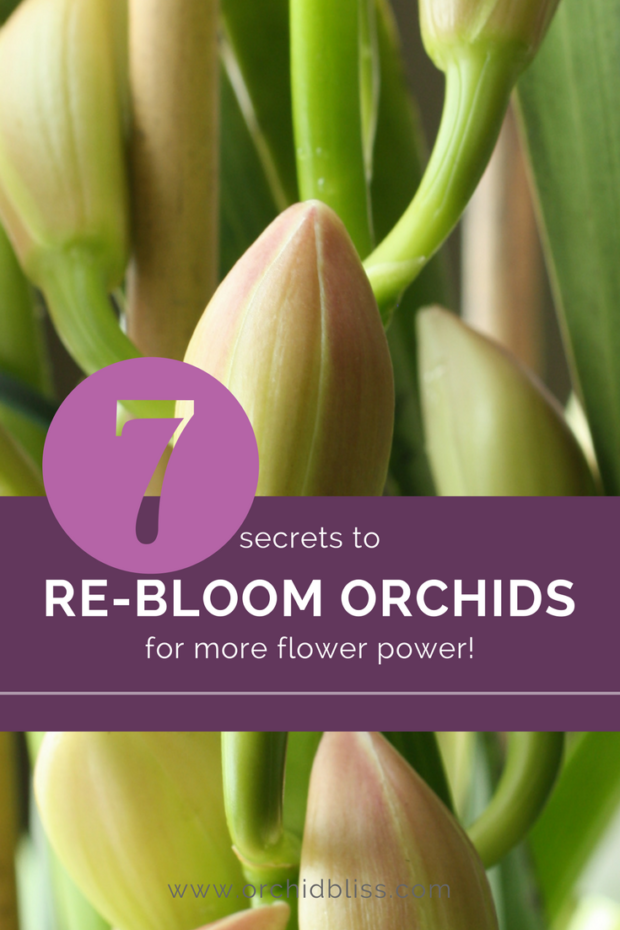
Some of the links on this page may be affiliate links. Click here to learn more.
To help you further, start by downloading my free cheat sheet to see where to cut the orchid flower spike after blooms have faded to trigger re-blooming. Click here for the cheat sheet. It’ll be super helpful.
# 1 Sufficient Light = Flowering Orchids
Following nature’s light cycle is important to reblooming an orchid. If the orchid is set in a window, particularly an east window, you won’t have to worry about making any adjustments–mother nature will take care of that.
Light Duration –How long do my orchids receive light?
If you are growing orchids under lights, try mimicking the sun’s cycle. Leave the lights on longer in the summer and shorter in the winter.
One way to know if your orchid is getting enough light is to let leaf color be your guide. Leaf color is the best indicator of sufficient light. Dark green leaves imply not enough light. Medium to light green leaves points to sufficient light.
Light Intensity – How strong is the light that my orchids receive?
Along with adjusting light duration, it is also important to make sure that your orchids receive the light intensity that they require to flower. Light intensity for orchids is commonly measured in foot candles (fc) and in lux.
Check out this table of commonly cultivated orchids and their light intensity requirements.
Determining light intensity is as easy as downloading an app on your phone that measures the light. Next, use the app to measure the light. Then, if you find that your orchid lacks sufficient light, be willing to make a few adjustments.
Here are a few suggestions on how to add or subtract light.
- Move the orchid to a different room in your house with more, or less, light.
- Add a sheer curtain to a window if the light is too strong.
- To add more light, supplement natural light with artificial LED or fluorescent light. CLICK HERE, to learn more about artificial light – specifically more about how to choose your lights for optimal light quality.
NOTE: If you decide that your orchid requires more light, slowly adjust your orchid to more light. Otherwise the orchid’s leaves will likely sunburn.
To learn more about light to rebloom your orchids, click here.
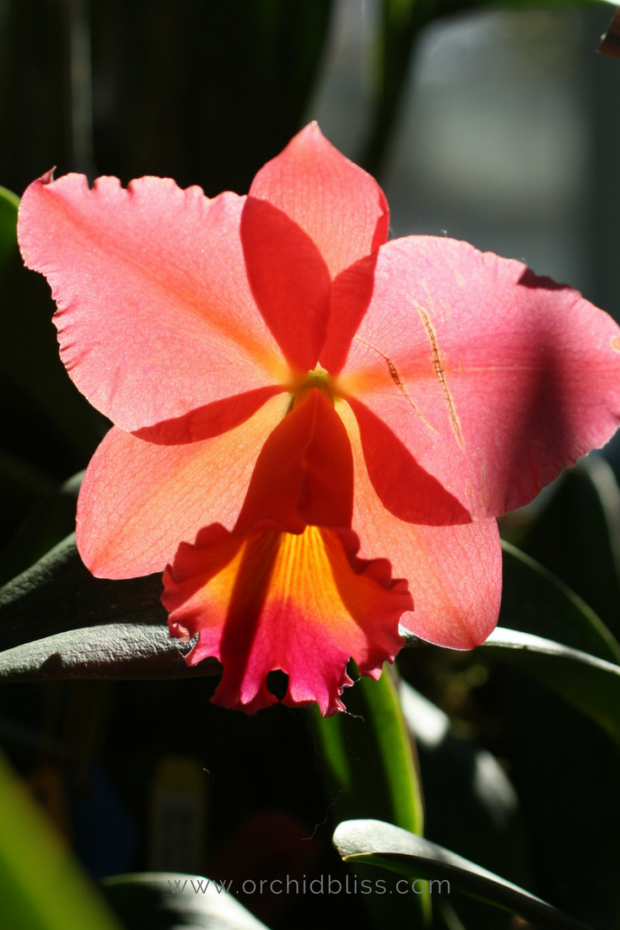
Providing your orchid with the right light is key to reblooming your orchid
# 2 The Right Temperature is Key to ReBlooming Orchids
Temperature is an important, yet often undervalued, consideration to rebloom orchids. Most orchids will react to a temperature swing.
For example, once a Phalaenopsis has finished blooming, set it in a cool spot to trigger re-blooming–about 60°F/15.5°C, for about three-four weeks. An easy way to accomplish this, if it’s not too cold outside, is to crack a window before going to bed, and closing it again in the morning. This mimics their natural rainforest environment where temperatures cool down at night.
Cymbidiums, in particular, need a drop in temperature to trigger reblooming. These are good plants to set outside for the summer and bring inside, to enjoy the flowers, in the winter. These plants can be kept outside until it gets down into the 40°sF/4.4°C. It’s those lower temperatures that send the signal to re-bloom.
Orchids are most likely to bloom when grown in the temperature they prefer. Some orchids are considered warm growers, intermediate growers, or cool growers. Choose orchids that best suit your growing conditions. For most people, warm and intermediate growing conditions can be met in a typical home environment.
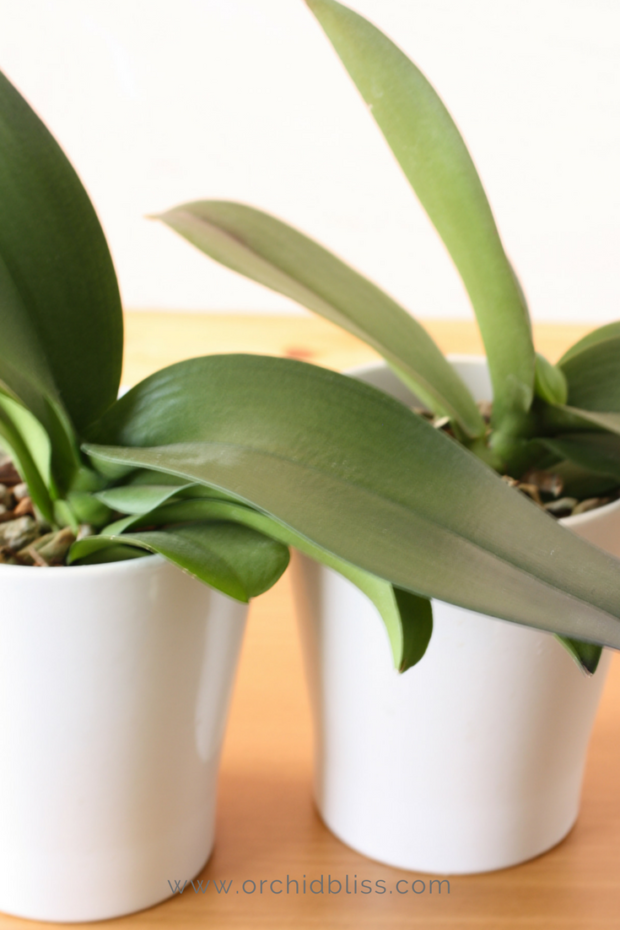
Temperature, especially during the winter, is crucial to rebloom orchids.
Warm Growers | Intermediate Growers | Cool Growers |
65°-85° F/18.3° 24.9° C. | 60º-80°F/15.5°-26.6°C | 50° - 75° F / 10° - 23.9° C |
TIP: For most of us, it’s the cool growers that are hard to get to rebloom as getting our homes that cool can be tricky.
# 3 Cutting the Flower Spike Prepares Orchids to Bloom Again
Most orchids bloom only once from each flower stalk – the exceptions being Phragmipedium and Phalaenopsis orchids. Phragmipedium can bloom for several months off the same stalk. Phalaenopsis flower stalks can continue to grow and produce flowers.
In the case of Phragmipedium orchids, it is best to leave the flower stalk alone until the flower stalk stops producing buds.
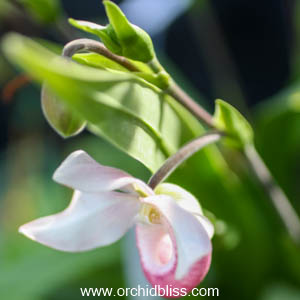
See the new flower bud growing on the same stalk as the mature flower.
Phalaenopsis, on the other hand, perform best if they are only allowed to produce their first flush of blooms and perhaps a few more. Then it is time to cut the flower stalk down to about 1-inch above the last node near the crown.
By cutting the flower stalk you give your Phalaenopsis time to recharge and build up energy to bloom again, rather than expending energy on smaller and smaller blooms.
Regarding the vast majority of other orchids that do not continue to produce flowers on the same flower stalk, it is best to use sterilized shears and trim off the stalk after the orchid has finished blooming. A cleaned-up, well-groomed orchid gives pests fewer places to hide.
# 4 Feed Your Orchid: Fertilizer
Switching from a balanced fertilizer, such as 10-10-10, to a fertilizer with higher phosphorus content, such as 3-12-6, will give your orchids an extra boost that will promote flowering.
When buds begin to grow, hold off on fertilizer until all the flowers have opened. Waiting to fertilize will help protect the buds, as they are the most fragile part of the orchid plant.
Likewise, if the orchid is dormant or resting, meaning the plant is not flowering, growing new leaves or roots, wait to fertilize. A resting period for the orchid is completely normal. Wait until new growth is observed, then begin fertilizing again.
For more information, be sure to check out my post on fertilizing orchids. Just as fertilizing orchids will help them to rebloom, too much fertilizer will inhibit flowering, so be judicious in your use of fertilizer. Less is more.
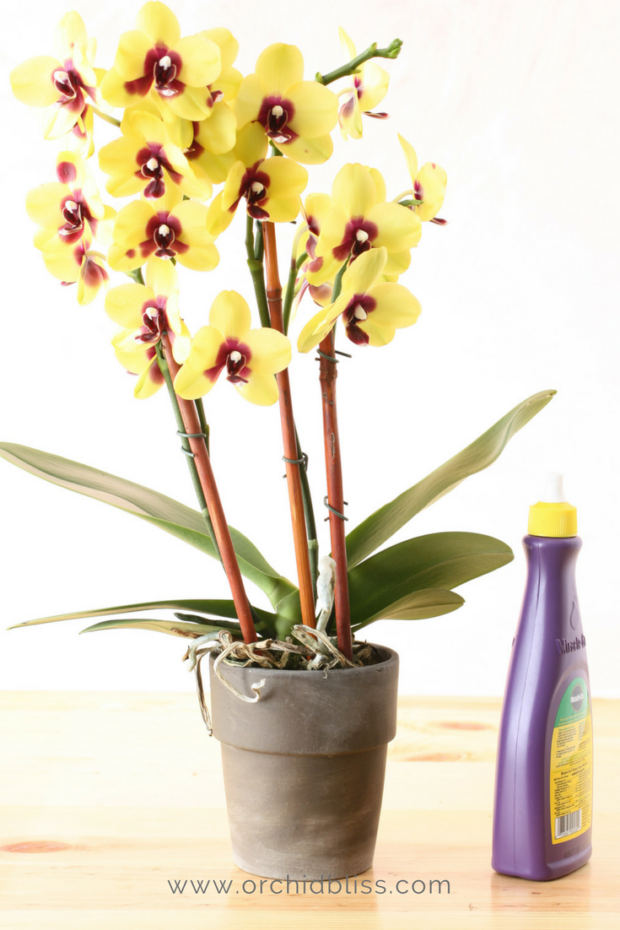
Feeding your orchids will give them essential nutrients to enhance blooming.
#5 Water as a Tool to ReBloom Orchids
It is crucial to avoid overwatering as it may result in not only a non-blooming orchid but also its eventual demise. When an orchid is dormant, use good judgment, don’t let the orchid completely dry out either. Water sparingly.
To learn more about how to water your orchids, click here.
# 6 Don’t Let Lack of Humidity Keep Your Orchid From Blooming
Orchids release oxygen and water through tiny openings in their leaves, called stomata. Through the stomata, orchids absorb carbon dioxide and water. This process is called transpiration – imagine it as plant breathing. If there is not enough water vapor, humidity, in the air the orchid will close its stomata. This is analogous to an orchid holding its breath.
Humidity matters. For optimal health, there must be a balance between water vapor exchanged through the leaves.
Orchids that require high levels of humidity may lose their ability to bloom if humidity levels drop.
To learn more about how to provide humidity for your orchids, CLICK HERE.
# 7 Immaturity: Give a Young Orchid a Chance to Grow Up
A young orchid may need time to grow up a bit before flowering. It takes a seedling between 2 and 4 years before it reaches maturity and will be able to flower. To avoid this scenario, before purchasing from a vendor, ask if the orchid has reached maturity.
Young orchids are less costly than mature orchids. In fact, many orchid hobbyists purchase young orchids with the expectation that given time, the orchid will mature and bloom.
# 8 Time: Orchids Need Recovery Time Between Flowering
Flowering takes a lot of energy. When your orchid is not in bloom use this time as an opportunity to give it the care it needs.
In particular, pay attention to light and temperature. Be sure your orchid has adequate light and make adjustments as necessary.
Another consideration is temperature. Be sure that if your orchid needs a cooling-off period to initiate blooming that you provide the needed temperature requirements.
Beyond light and temperature, water is also important. If the orchid is growing, more water, and even fertilizer, is needed, but if the orchid is resting, less frequent water accompanied by a break from fertilizer will help your orchid recover and build up strength to bloom again.
As noted below, learning your orchid’s growth cycle will help you know when to expect flowers, and when to expect a rest.
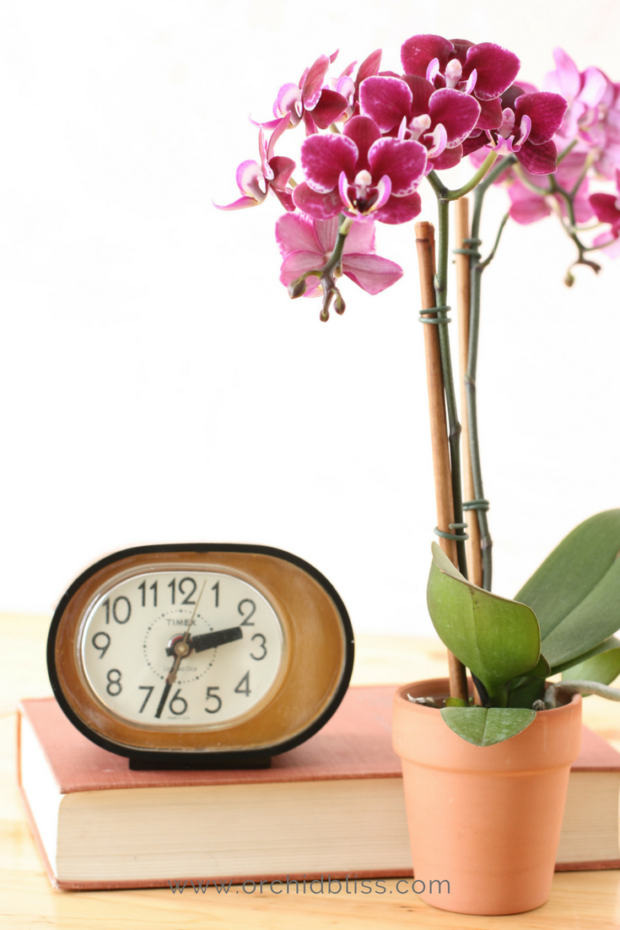
# 9 Learning Your Orchid Growth Cycle Will Help You Determine When Your Orchid is Ready to Produce Flowers
The adage that good things come to those that wait is true when re-blooming orchids. It takes a month or two, or even several months for Phalaenopsis orchids to rebloom. Many other varieties of orchids bloom annually.
The anticipation and eventual reward of an emerging flower spike bedecked with tiny buds are so exciting. Stopping to admire and examine the buds may become a happy habit.
Orchid Growth Cycle
There are 4 stages that orchids experience: leaf growth, flowering, root growth, and dormancy. Being able to identify these stages can help us provide better care of our orchids. For instance, during the dormant period, we can feel confident that leaving off with the fertilizer and watering sparingly is the correct action.
Likewise, we will know that during the root and leaf growth period the orchid is still working. It is doing what it is supposed to do. Be patient with the knowledge that even if the orchid is not currently in flower, it is powering up to do so. It also helps to recognize that while Phalaenopsis orchids can re-bloom every few months, most others will bloom annually.
TIP: Not all orchids experience dormancy. Some orchids continue to grow year-round.
To learn more about your orchid’s growth cycle, CLICK HERE.
# 10 Bad Genes Can Inhibit Orchids From ReBlooming
Sometimes you may just have a poor cultivar. This is something that is out of your control. The orchid will never bloom, even when you’re doing everything right. To avoid this problem, purchase award-winning cultivars, or buy plants already in bloom, or with buds.
# 11 Jewel Orchids = Focus on Foliage
One workaround while waiting for your orchids to bloom is to grow jewel orchids. Unlike most orchids, these orchids are grown for delicate leaf patterns rather than for their flowers.
Before investing in these highly treasured orchids, find out if you can give them proper care.
BONUS: These are low-light orchids. For many of us, that’s good news!
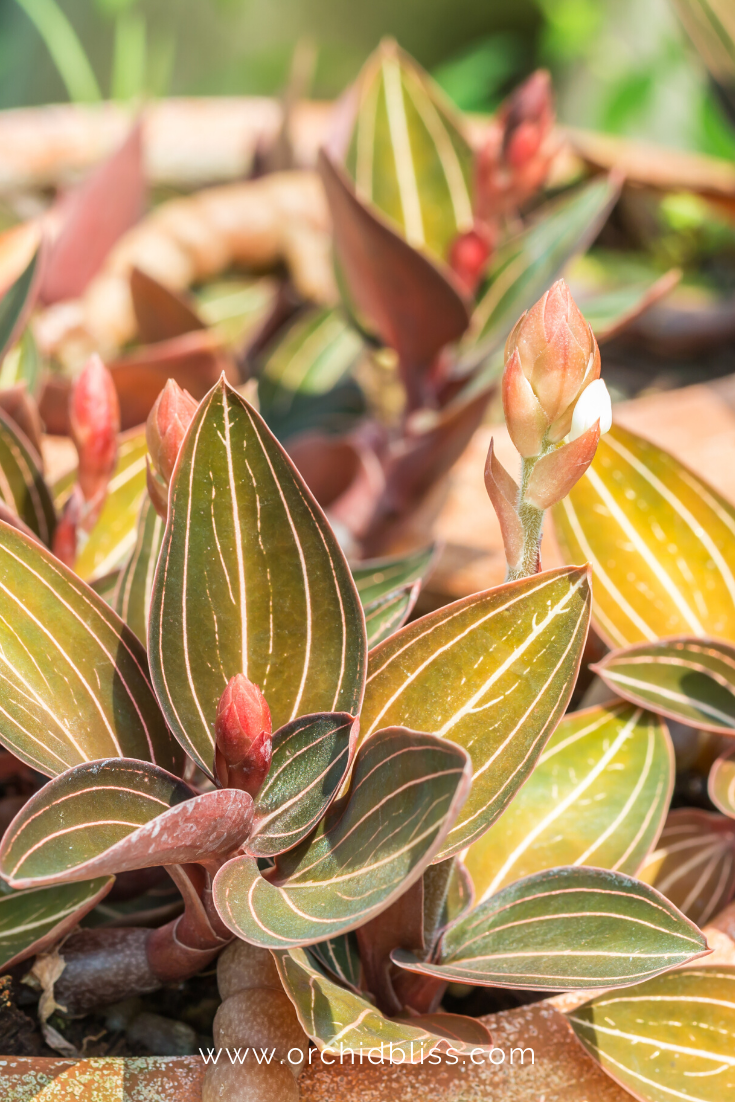
Jewel Orchid Care Requirements
These orchids enjoy high humidity – levels above 60%. If humidity is a problem, these orchids, fortunately, grow well in terrariums. This is interesting because most other orchids need constant air movement and languish in terrariums.
Just as these orchids require high humidity, they also like water. Do not let your jewel orchids dry out. Instead, keep the potting mix evenly moist.
Finally, the last consideration is temperature. These orchids prefer temperatures between 70°-85°F / 21°-29.4°C during the day and nighttime temperatures between 60°-68°F / 15.5°-20°C
# 12 Limit Orchid Variety
If it really is orchid flowers you are interested in, another option is to invest in a limited variety of orchids that bloom at different times.
I suggest a limited variety because you can spread yourself too thin by growing too many varieties of orchids.
Tag Team Flowering
Many orchid enthusiasts specialize in just a few orchid varieties with similar growing conditions.
For example, phalaenopsis, paphiopedilum, and dendrobium phalaenopsis are easy to grow alongside each other and will result in extending blooming periods.
Even growing the same genus of orchids can result in prolific blooming. By investing in several phalaenopsis orchids you can have several that take turns flowering.
By the same token, some enthusiasts grow nothing but cattleyas. You can purchase cattleyas that bloom during different seasons.
# 13 Pests and Disease
Not only are pests and diseases bad for orchid plants, but they can also severely diminish the beauty of the flowers.
A symptom of botrytis, a fungal infection, is spotted flowers. Other infections manifest themselves with malformed flowers. Color breaks or streaking is a symptom of viral infections. Disease-spreading insects such as aphids like to feast on new growth – like flower buds.
To grow healthy orchids, with great-looking flowers, CLICK HERE for important information on how to prevent, identify, and treat pests and diseases that can attack orchids.
# 14 Not a Good Fit
Maybe your orchid just isn’t a good fit. For example, growing a vanda orchid outdoors is a walk in the park if you live in South Florida, but even in a mild climate like southern California it just isn’t quite tropical enough for a vanda to thrive.
Another common scenario is moving to a new location. I’ve received numerous emails from people who grew thriving orchids in one climate and then moved to another (usually drier) only to watch their orchids struggle.
Perhaps you’ve done your homework and purchased an orchid that should do well, but just doesn’t.
In each of these scenarios it doesn’t mean you should give up on orchids, it just means that adjustments need to be made.
Determine what your climate is like. Consider what adjustments you are willing to make (ie humidifier, artificial lighting). Lastly, match the orchids with your growing environment.
# 15 Orchids with Particularly Extraordinary Flowers
If you are reading this article, and especially if you’ve made it this far down the post, I know you have a special fondness for orchid flowers. With that in mind, I’ve compiled a shortlist of orchids with, particularly interesting flowers. I’ve limited this section to only a few select orchids and is certainly not exhaustive.
Cattleya and Its Many Hybrids
When many people think of orchids it is the cattleya that comes to mind, and for good reason. These beauties have been hybridized producing many spectacular and easy-to-grow specimens.
You might begin, as I did, with some compact, miniature varieties. Some growers are so enthralled with cattleyas that they refuse to grow anything else. And who can blame them as there is so much variety?

A lovely Cattleya orchid.
Lycaste
Many orchid lovers consider Lycaste blooms to be the most beautiful of all orchid flowers. The best part is that some varieties are well-suited for windowsill growers.
Begin with easier varieties, such as Lycaste aromatica. Though these orchids grow smaller flowers, they require more moderate temperatures and lower humidity levels than their larger-flowered Andean counterparts.
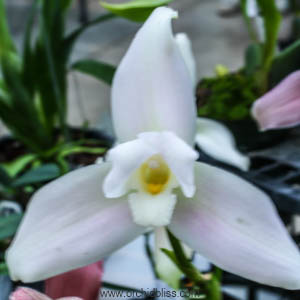
Considered by many to be the most beautiful of all orchid flowers – the Lycaste.
Paphiopedilum and Phragmipedium
Both paphiopedilum and Phragmipedium orchids possess prominent lower lips. They are in the love-it-or-hate-it camp. Paphiopedilum orchids are considered the easier of the two to grow.
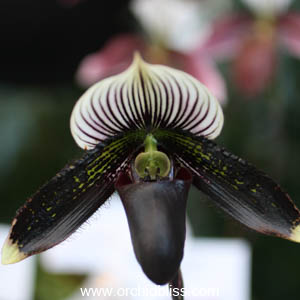
An extraordinary black Paphiopedilum orchid.
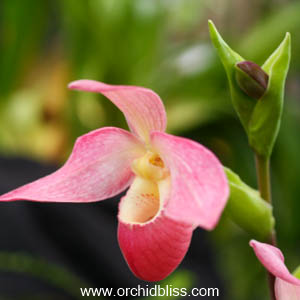
Phragmipedium orchids dazzle with their prominent lower lip.
I’m stopping here, but there are so many exquisitely beautiful orchids that I recommend attending an orchid show to discover your favorites for yourself.
# 16 Orchids That Are Easier to ReBloom
Easy-to-bloom orchids usually translate into orchids with growing requirements similar to typical household temperatures with minimal humidity and light adjustments.
I use the term ‘typical’ to mean around 70°-77°F / 21°-25°C, recognizing that typical for you could mean temperatures much higher or lower. Many households have humidity levels down around 10%, while others may have much, much higher relative humidity.
Likewise, some homes are flush with large windows and natural light, while other homes may have small windows with large trees or buildings that block light.
Every home is different, and we all have to work with what we have. That’s life, right? That said, here are 5 orchids that are known as easy-to-bloom.
5 Easy-to-Bloom Orchids
- Phalaenopsis. This graceful favorite is found in grocery stores and home decor magazines around the world. Just because it is more commonly found doesn’t make it any less amazing than other orchids.
- Phalaenopsis-type Dendrobiums. These dendrobium orchids have a phalaenopsis-like flower, though the rest of the plant definitely looks like a dendrobium with canes and a sympodial (grows along a horizontal rhizome, rather than a single stem) growth habit.
- Miniature Cymbidiums. Traditionally cymbidiums are large orchids that need a cool winter that can be hard for many growers to achieve. There are now smaller varieties with more moderate temperature requirements that make these beauties easier to grow and rebloom.
- Oncidiums such as ‘dancing lady,’ ‘sharry baby’, and ‘twinkle’. All three of these oncidiums are fragrant, have lower humidity requirements, can be grown in a bright window with indirect light, and produce sprays of flowers.
- Lastly, the zygopetalum is another fragrant orchid you can grow in a bright window. For best results, plant in a well-draining mix and water to keep barely damp.
For a more expansive list of easy-to-grow orchids, CLICK HERE.
# 17 Peak Blooming Seasons for Specific Orchids
If you’re interested in having at least one orchid in bloom at all times, or at least nearly all the time, here’s a chart that shows when some of the most popular orchids are most likely in bloom.
Cattleya | Spring |
Cymbidium | Midwinter to Early Spring |
Dendrobium | Late Fall - Winter |
Oncidium | April - July |
Paphiopedilum | Late Fall to Late Spring |
Phalaenopsis | Anytime |
Zygopetalum | Winter |
# 18 Protecting the Buds
After providing the right growing environment for your orchid, complete with proper temperature, light, and water, and a flower stalk has begun to grow, you’ll need to protect the buds.
It is extremely disheartening to have seemingly perfect buds wither and die – and for no apparent reason.
When buds abort it is called bud blast and is usually the result of environmental stress. As the most delicate part of the orchid plant, the buds are the first to show signs of stress.
To help you protect your carefully tended orchid from bud blast here are some precautions you can take:
- Protect your orchid from drafts. Inventory all exterior doors, heating, and cooling vents, and heat sources (wood-burning stoves). Before placing your orchid in a particular location, imagine how drafts will impact your orchid. If needed, move your orchid to a safer location.
- Regulate watering. Irregular watering is a sure way to shrivel orchid buds. Don’t neglect your orchids when your schedule gets busy, guests come and stay, or when you’re on vacation. Instead, plan ahead, make arrangements, and set alarms on your phone to remind you to check on your orchids.
- Be aware of pollutants. Orchids are sensitive to pollution. Be sure that vents are in working order. This precaution will protect you and your orchids.
- Take a break from fertilizer. After the buds have opened, resume fertilizing your orchid every-other-week or so at ½ to ¼ strength.
# 19 Your Orchid Has Bloomed – Now What?
After all the work you’ve done and all the love you’ve given, take care to protect your orchid from heat.
Just as direct sunlight will burn your orchid’s leaves, heat coming in from a window can cause the flowers to wilt prematurely.
Move your orchid a few feet back from intense sunlight coming in from a window and turn on a fan. Air movement will help prevent infections and mix hot and cold air for more moderate temperatures.
Continue to water your orchid as flowering is often a time of active growth when leaves and roots may also be growing.
If you stopped fertilizing during bud development, now that the flowers have opened, resume feeding your orchid.
TIP: Take a picture to remember the why. Since flowers don’t last forever, a photo can serve as a nice reminder during the months between flowers as to the reasons why you are taking such good care of your orchid.
# 20 Prepare Your Orchid to Bloom Again
Depending on your orchid, the flowers will last anytime from a few days to months on end. After blooming is complete, it is time to prepare your orchid to bloom again.
As noted above, many orchids will rest after flowering. For some orchids, this means little to no water and no fertilizer. Despite the need for less water, do provide your orchid with higher light, cooler temperatures, and frequent misting.
If you do continue to water an orchid that is native to a climate with a distinct dry season it is likely that the orchid will rot and die.
One way to tell if your orchid does NOT require a dry, winter rest is to see if it continues to put out new growths. If the orchid keeps growing, it likely does not have a dry rest.
It is always a good idea to ask the seller what kind of winter care your orchid needs. If you know the type of orchid you are growing, you can always Google it.
Your Turn
As nice as orchid leaves are, that’s not really where the hype is. We want flowers! (Unless, of course, we are growing Jewel orchids.) It can be really frustrating to have enjoyed the blooms, only to have them fade away, while the plant just seems to sit there, doing nothing.
As you can see there are several factors that influence when an orchid reblooms or, frustratingly, when it doesn’t. The good news is that there is lots of room for experimentation. Decide which areas your orchids could use a little boost and see if you can trigger blooming. Be patient. Don’t expect overnight results, but do expect gradual improvement.
Soon you’ll stop wondering, Do orchids bloom more than once? You will know for yourself that, yes, they do. I promise, it’s a very good feeling when you see that flower spike start to grow!
You’ve got this! You’re ready to rebloom orchids.
Ready to Learn More?

